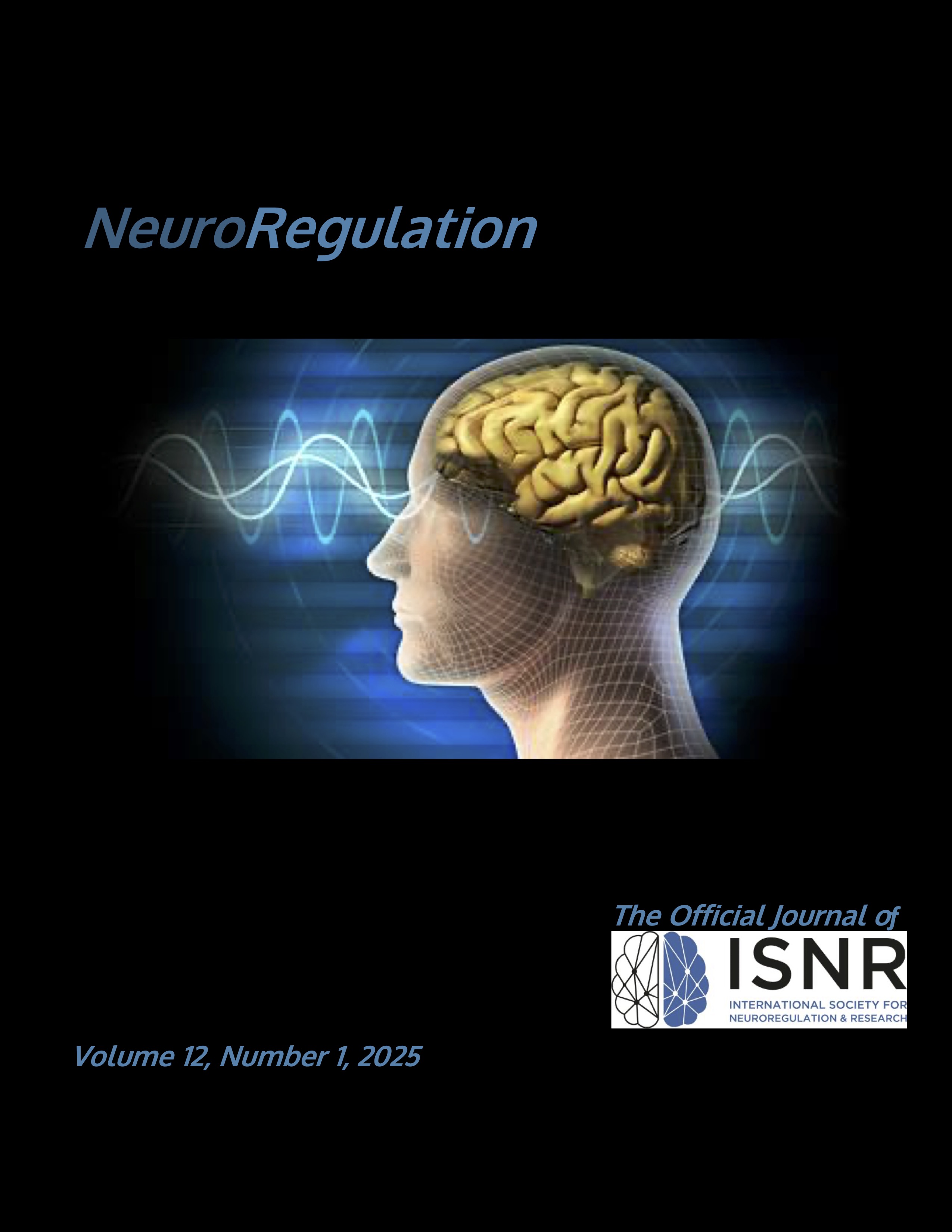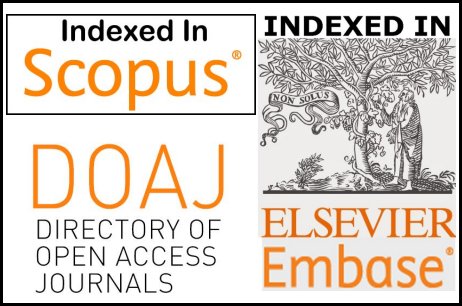EEG Signatures of Resilience Across Individuals With High and Low Anxiety
DOI:
https://doi.org/10.15540/nr.12.1.12Keywords:
resilience, Anxiety, EEG, young adults, neuropsychologyAbstract
Background. Over the past decade, psychological resilience has become a key focus in psychological science. However, most research relies on self-report and psychosocial assessments to explore resilience across different populations and contexts. Methods. This two-phased study examined resilience using self-reported measures and EEG recordings. Phase 1 involved a cross-sectional analysis of resilience and anxiety in young adults using correlation and regression analysis. Phase 2 utilized a grouped experimental design with EEG resting-state recordings to compare high- and low-resilience individuals. EEG data were collected using a 64-channel Geodesic Sensor Net, NetAmps 400 Amplifiers, and NetStation Acquisition 5.0 Software. Spectral analysis was performed for group comparisons. Results. Significant EEG differences emerged between high- and low-resilience groups in the anterior midline, right frontal, right central, left parietal, and right parietal regions. Alpha band differences were predominantly frontal and right-sided, while beta band differences were posterior and left-sided. Conclusions. Results of the two phased study bridge the gap between psychosocial measures and electrophysiological measures in the study of resilience and anxiety. A conceptual model based on the findings is outlined to guide future research to investigate the mechanism between resilience and clinical presentations of anxiety and/or depression at the psychosocial and electrophysiological level.
References
Ambrosini, E., & Vallesi, A. (2016). Asymmetry in prefrontal resting-state EEG spectral power underlies individual differences in phasic and sustained cognitive control. NeuroImage, 124(Part A), 843–857. https://doi.org/10.1016/j.neuroimage.2015.09.035
Baranauskas, M. C. C. (2009). Socially aware computing. In ICECE 2009: VI International conference on engineering and computer education (pp. 1–5).
Beck, A. T., Brown, G., Steer, R. A., & Weissman, A. N. (1991). Factor analysis of the Dysfunctional Attitude Scale in a clinical population. Psychological Assessment: A Journal of Consulting and Clinical Psychology, 3(3), 478–483. https://doi.org/10.1037/1040-3590.3.3.478
Beck, A. T., Steer, R. A., & Carbin, M. G. (1988). Psychometric properties of the Beck Depression Inventory: Twenty-five years of evaluation. Clinical Psychology Review, 8(1), 77–100. https://doi.org/10.1016/0272-7358(88)90050-5
Bolsinger, J., Seifritz, E., Kleim, B., & Manoliu, A. (2018). Neuroimaging correlates of resilience to traumatic events—A comprehensive review. Frontiers in Psychiatry, 9, Article 693. https://doi.org/10.3389/fpsyt.2018.00693
Bonanno, G. A. (2004). Loss, trauma, and human resilience: Have we underestimated the human capacity to thrive after extremely aversive events? American Psychologist, 59(1), 20–28. https://doi.org/10.1037/0003-066X.59.1.20
Bonanno, G. A., & Diminich, E. D. (2013). Annual research review: Positive adjustment to adversity—Trajectories of minimal–Impact resilience and emergent resilience. Journal of Child Psychology and Psychiatry, 54(4), 378–401. https://doi.org/10.1111/jcpp.12021
Bush, G., Luu, P., & Posner, M. I. (2000). Cognitive and emotional influences in anterior cingulate cortex. Trends in Cognitive Sciences, 4(6), 215–222. https://doi.org/10.1016/S1364-6613(00)01483-2
Campbell-Sills, L., Cohan, S. L., & Stein, M. B. (2006). Relationship of resilience to personality, coping, and psychiatric symptoms in young adults. Behaviour Research and Therapy, 44(4), 585–599. https://doi.org/10.1016/j.brat.2005.05.001
Cathomas, F., Murrough, J. W., Nestler, E. J., Han, M.-H., & Russo, S. J. (2019). Neurobiology of resilience: Interface between mind and body. Biological Psychiatry, 86(6), 410–420. https://doi.org/10.1016/j.biopsych.2019.04.011
Chapman, L. K., Williams, S. R., Mast, B. T., & Woodruff-Borden, J. (2009). A confirmatory factor analysis of the Beck Anxiety Inventory in African American and European American young adults. Journal of Anxiety Disorders, 23(3), 387–392. https://doi.org/10.1016/j.janxdis.2008.12.003
Charney, D. S. (2004). Psychobiological mechanisms of resilience and vulnerability: Implications for successful adaptation to extreme stress. American Journal of Psychiatry, 161, 195–216. https://doi.org/10.1176/appi.ajp.161.2.195
Chen, D., Wu, J., Yao, Z., Lei, K., Luo, Y., & Li, Z. (2018). Negative association between resilience and event-related potentials evoked by negative emotion. Scientific Reports, 8, Article 7149. https://doi.org/10.1038/s41598-018-25555-w
Chesak, S. S., Khalsa, T. K., Bhagra, A., Jenkins, S. M., Bauer, B. A., & Sood, A. (2019). Stress management and resiliency training for public school teachers and staff: A novel intervention to enhance resilience and positively impact student interactions. Complementary Therapies in Clinical Practice, 37, 32–38. https://doi.org/10.1016/j.ctcp.2019.08.001
Cicchetti, D. (2010). Resilience under conditions of extreme stress: A multilevel perspective. World Psychiatry, 9(3), 145–154. https://doi.org/10.1002/j.2051-5545.2010.tb00297.x
Çiçek, M., & Nalçacı, E. (2001). Interhemispheric asymmetry of EEG alpha activity at rest and during the Wisconsin Card Sorting Test: Relations with performance. Biological Psychology, 58(1), 75–88. https://doi.org/10.1016/S0301-0511(01)00103-X
Coan, J. A., & Allen, J. J. B. (2004). Frontal EEG asymmetry as a moderator and mediator of emotion. Biological Psychology, 67(1–2), 7–50. https://doi.org/10.1016/j.biopsycho.2004.03.002
Cohen, S., Kamarck, T., & Mermelstein, R. (1994). Perceived stress scale. Measuring stress: A guide for health and social scientists, 10(2), 1–2.
Connor, K. M., & Davidson, J. R. (2003). Development of a new resilience scale: The Connor‐Davidson Resilience Scale (CD‐RISC). Depression and Anxiety, 18(2), 76–82. https://doi.org/10.1002/da.10113
Crane, M. F., Searle, B. J., Kangas, M., & Nwiran, Y. (2019). How resilience is strengthened by exposure to stressors: The systematic self-reflection model of resilience strengthening. Anxiety, Stress, & Coping, 32(1), 1–17. https://doi.org/10.1080/10615806.2018.1506640
Creamer, M., Foran, J., & Bell, R. (1995). The Beck Anxiety Inventory in a non-clinical sample. Behaviour Research and Therapy, 33(4), 477–485. https://doi.org/10.1016/0005-7967(94)00082-U
Curtis, W. J., & Cicchetti, D. (2007). Emotion and resilience: A multilevel investigation of hemispheric electroencephalogram asymmetry and emotion regulation in maltreated and normally treated children. Developmental Psychopathology, 19(3), 811–840. https://doi.org/10.1017/S0954579407000405
Daselaar, S. M., Prince, S. E., Dennis, N. A., Hayes, S. M., Kim, H., & Cabeza, R. (2009). Posterior midline and ventral parietal activity is associated with retrieval success and encoding failure. Frontiers in Human Neuroscience, 3, Article 13. https://doi.org/10.3389/neuro.09.013.2009
Davidson, R. J., & McEwen, B. S. (2012). Social influences on neuroplasticity: Stress and interventions to promote well-being. Nature Neuroscience, 15(5), 689–695. https://doi.org/10.1038/nn.3093
de Kloet, E. R., Joëls, M., & Holsboer, F. (2005). Stress and the brain: From adaptation to disease. Nature Reviews Neuroscience, 6(6), 463–475. https://doi.org/10.1038/nrn1683
Delorme, A., & Makeig, S. (2004). EEGLAB: An open source toolbox for analysis of single-trial EEG dynamics including independent component analysis. Journal of Neuroscience Methods, 134(1), 9–21. https://doi.org/10.1016/j.jneumeth.2003.10.009
Dooley, L. N., Slavich, G. M., Moreno, P. I., & Bower, J. E. (2017). Strength through adversity: Moderate lifetime stress exposure is associated with psychological resilience in breast cancer survivors. Stress and Health, 33(5), 549–557. https://doi.org/10.1002/smi.2739
Dray, J., Bowman, J., Campbell, E., Freund, M., Wolfenden, L., Hodder, R. K., McElwaine, K., Tremain, D., Bartlem, K., Bailey, J., Small, T., Palazzi, K., Oldmeadow, C., & Wiggers, J. (2017). Systematic review of universal resilience-focused interventions targeting child and adolescent mental health in the school setting. Journal of the American Academy of Child & Adolescent Psychiatry, 56(10), 813–824. https://doi.org/10.1016/j.jaac.2017.07.780
Feder, A., Fred-Torres, S., Southwick, S. M., & Charney, D. S. (2019). The biology of human resilience: Opportunities for enhancing resilience across the life span. Biological Psychiatry, 86(6), 443–453. https://doi.org/10.1016/j.biopsych.2019.07.012
Feder, A., Nestler, E. J., & Charney, D. S. (2009). Psychobiology and molecular genetics of resilience. National Review Neuroscience, 10(6), 446–457. https://doi.org/10.1038/nrn2649
Fleshner, M., Maier, S. F., Lyons, D. M., & Raskind, M. A. (2011). The neurobiology of the stress-resistant brain. Stress, 14(5), 498–502. https://doi.org/10.3109/10253890.2011.596865
Fletcher, D., & Sarkar, M. (2013). Psychological resilience: A review and critique of definitions, concepts, and theory. European Psychologist, 18(1), 12–23. https://doi.org/10.1027/1016-9040/a000124
Franklin, T. B., Saab, B. J., & Mansuy, I. M. (2012). Neural mechanisms of stress resilience and vulnerability. Neuron, 75(5), 747–761. https://doi.org/10.1016/j.neuron.2012.08.016
Gupta, S. (2021). Bouncing back! Clinical intersections of resilience, cognitive behavioural neuropsychology, and psychoneuroimmunology (PNI): An introduction. Resilience, psychoneuroimmunology, neuropsychology: Applications in clinical settings. Google Books.
Gupta, S., & McCarthy, P. J. (2021). Sporting resilience during COVID-19: What is the nature of this adversity and how are competitive elite athletes adapting? Frontiers in Psychology, 12, Article 611261. https://doi.org/10.3389/fpsyg.2021.611261
Gupta, S., & McCarthy, P. J. (2022). The sporting resilience model: A systematic review of resilience in sport performers. Frontiers in Psychology, 13, 1003053. https://doi.org/10.3389/fpsyg.2022.1003053
Holman, E. A., Lucas-Thompson, R. G., & Lu, T. (2011). Social constraints, genetic vulnerability, and mental health following collective stress. Journal of Trauma and Stress, 24, 497–505. https://doi.org/10.1002/jts.20671
Holz, N. E., Tost, H., & Meyer-Lindenberg, A. (2020). Resilience and the brain: A key role for regulatory circuits linked to social stress and support. Molecular Psychiatry, 25(2), 379–396. https://doi.org/10.1038/s41380-019-0551-9
Hong, L. E., Buchanan, R. W., Thaker, G. K., Shepard, P. D., & Summerfelt, A. (2008). Beta (∼16 Hz) frequency neural oscillations mediate auditory sensory gating in humans. Psychophysiology, 45(2), 197–204 https://doi.org/10.1111/j.1469-8986.2007.00624.x
Hoorelbeke, K., Koster, E. H., Demeyer, I., Loeys, T., & Vanderhasselt, M.-A. (2016). Effects of cognitive control training on the dynamics of (mal)adaptive emotion regulation in daily life. Emotion, 16(7), 945. https://doi.org/10.1037/emo0000169
Ioannidis, K., Askelund, A. D., Kievit, R. A., & van Harmelen, A.-L. (2020). The complex neurobiology of resilient functioning after childhood maltreatment. BMC Medicine, 18(1), Article 32. https://doi.org/10.1186/s12916-020-1490-7
Jefferies, P., Höltge, J., & Ungar, M. (2021). Social anxiety and resilience: Associations vary by country and sex. Adversity and Resilience Science, 2(1), 51–62 https://doi.org/10.1007/s42844-020-00026-2
Joëls, M., Karst, H., Krugers, H. J., & Lucassen, P. J. (2007). Chronic stress: Implications for neuronal morphology, function, and neurogenesis. Frontiers in Neuroendocrinology, 28(2–3), 72–96. https://doi.org/10.1016/j.yfrne.2007.04.001
Jones, H. J., Stergiakouli, E., Tansey, K. E., Hubbard, L., Heron, J., Cannon, M., Holmans, P., Lewis, G., Linden, D. E. J., Jones, P. B., Davey Smith, G., O’Donovan, M. C., Owen, M. J., Walters, J. T., & Zammit, S. (2016). Phenotypic manifestation of genetic risk for schizophrenia during adolescence in the general population. JAMA Psychiatry, 73(3), 221–228. https://doi.org/10.1001/jamapsychiatry.2015.3058
Joormann, J., & Vanderlind, W. M. (2014). Emotion regulation in depression: The role of biased cognition and reduced cognitive control. Clinical Psychological Science, 2(4), 402–421 https://doi.org/10.1177%2F2167702614536163
Kahl, M., Wagner, G., de la Cruz, F., Köhler, S., & Schultz, C. C. (2020). Resilience and cortical thickness: A MRI study. European Archives of Psychiatry and Clinical Neuroscience, 270(5), 533–539. https://doi.org/10.1007/s00406-018-0963-6
Keynan, J. N., Cohen, A., Jackont, G., Green, N., Goldway, N., Davidov, A., Meir-Hasson, Y., Raz, G., Intrator, N., Fruchter, E., Ginat, K., Laska, E., Cavazza, M., & Hendler, T. (2019). Electrical fingerprint of the amygdala guides neurofeedback training for stress resilience. Nature Human Behaviour, 3(1), 63–73. https://doi.org/10.1038/s41562-018-0484-3
Kim, K. J., & Bell, M. A. (2006). Frontal EEG asymmetry and regulation during childhood. Annals of the New York Academy of Sciences, 1094(1), 308–312. https://doi.org/10.1196/annals.1376.040
Kim, M. J. Loucks, R. A., Palmer, A. L., Brown, A. C., Solomon, K. M., Marchante, A. N., & Whalen, P. J. (2011). The structural and functional connectivity of the amygdala: From normal emotion to pathological anxiety. Behavioural Brain Research, 223(2), 403–410. https://doi.org/10.1016/j.bbr.2011.04.025
Kong, F., Hu, S., Wang, X., Song, Y., & Liu, J. (2015). Neural correlates of the happy life: The amplitude of spontaneous low frequency fluctuations predicts subjective well-being. NeuroImage, 107, 136–145. https://doi.org/10.1016/j.neuroimage.2014.11.033
Kyriazos, T. A., Stalikas, A., Prassa, K., Galanakis, M., Yotsidi, V., & Lakioti, A. (2018). Psychometric evidence of the Brief Resilience Scale (BRS) and modeling distinctiveness of resilience from depression and stress. Psychology, 9(7), 1828–1857. https://doi.org/10.4236/psych.2018.97107
Lee, E.-H. (2012). Review of the psychometric evidence of the perceived stress scale. Asian Nursing Research, 6(4), 121–127. https://doi.org/10.1016/j.anr.2012.08.004
Leyfer, O. T., Ruberg, J. L., & Woodruff-Borden, J. (2006). Examination of the utility of the Beck Anxiety Inventory and its factors as a screener for anxiety disorders. Journal of Anxiety Disorders, 20(4), 444–458. https://doi.org/10.1016/j.janxdis.2005.05.004
Liberzon I., & Sripada C. S. (2007). The functional neuroanatomy of PTSD: A critical review. Progress in Brain Research, 167, 151–169. https://doi.org/10.1016/S0079-6123(07)67011-3
Liu, J. J. W., Reed, M., & Girard, T. A. (2017). Advancing resilience: An integrative, multi-system model of resilience. Personality and Individual Differences, 111, 111–118. https://doi.org/10.1016/j.paid.2017.02.007
Luca, M. (2019). Maladaptive rumination as a transdiagnostic mediator of vulnerability and outcome in psychopathology. Journal of Clinical Medicine, 8(3), Article 314. https://doi.org/10.3390/jcm8030314
Luthar, S. S., Cicchetti, D., & Becker, B. (2000). Research on resilience: Response to commentaries. Child Development, 71(3), 573–575. https://doi.org/10.1111/1467-8624.00168
Mahan, A. L., & Ressler, K. J. (2012). Fear conditioning, synaptic plasticity and the amygdala: Implications for posttraumatic stress disorder. Trends in Neuroscience, 35(1), 24–35. https://doi.org/10.1016/j.tins.2011.06.007
Malhi, G. S., Das, P., Bell, E., Mattingly, G., & Mannie, Z. (2019). Modelling resilience in adolescence and adversity: A novel framework to inform research and practice. Translational Psychiatry, 9(1), Article 316. https://doi.org/10.1038/s41398-019-0651-y
Masten, A. S. (2001). Ordinary magic. Resilience processes in development. American Psychologist, 56(3), 227–238 https://doi.org/10.1037/0003-066X.56.3.227
Masten, A. S. (2015). Ordinary magic: Resilience in development. Guilford Publications.
Milad, M. R., Pitman, R. K., Ellis, C. B., Gold, A. L., Shin, L. M., Lasko, N. B., Zeidan, M. A., Handwerger, K., Orr, S. P., & Rauch, S. L. (2009). Neurobiological basis of failure to recall extinction memory in posttraumatic stress disorder. Biological Psychiatry, 66(12), 1075–1082. https://doi.org/10.1016/j.biopsych.2009.06.026
Miyake, A., Friedman, N. P., Emerson, M. J., Witzki, A. H., Howerter, A., & Wager, T. D. (2000). The unity and diversity of executive functions and their contributions to complex “frontal lobe” tasks: A latent variable analysis. Cognitive Psychology, 41(1), 49–100. https://doi.org/10.1006/cogp.1999.0734
Paban, V., Modolo, J., Mheich, A., & Hassan, M. (2019). Psychological resilience correlates with EEG source-space brain network flexibility. Network Neuroscience, 3(2), 539–550. https://doi.org/10.1162/netn_a_00079
Papousek, I., & Schulter, G. (2002) Covariations of EEG asymmetries and emotional states indicate that activity at frontopolar locations is particularly affected by state factors. Psychophysiology, 39(3), 350–360. https://doi.org/10.1017/S0048577201393083
Pernet, C. R., Appelhoff, S., Gorgolewski, K. J., Flandin, G., Phillips, C., Delorme, A., & Oostenveld, R. (2019). EEG-BIDS, an extension to the brain imaging data structure for electroencephalography. Scientific Data, 6(1), Article 103. https://doi.org/10.1038/s41597-019-0104-8
Prince-Embury, S. (2014). Three-factor model of personal resiliency and related interventions. In S. Prince-Embury & D. Saklofske (Eds.), Resilience interventions for youth in diverse populations (pp. 25–57). Springer. https://doi.org/10.1007/978-1-4939-0542-3_3
Putman, P., Verkuil, B., Arias-Garcia, E., Pantazi, I., & van Schie, C. (2014). EEG theta/beta ratio as a potential biomarker for attentional control and resilience against deleterious effects of stress on attention. Cognitive, Affective, & Behavioral Neuroscience, 14(2), 782–791. https://doi.org/10.3758/s13415-013-0238-7
Reynaud, E., Guedj, E., Souville, M., Trousselard, M., Zendjidjian, X., El Khoury-Malhame, M., Fakra, E., Nazarian, B., Blin, O., Canini, F., & Khalfa, S. (2013). Relationship between emotional experience and resilience: An fMRI study in firefighters. Neuropsychologia, 51(5), 845–849. https://doi.org/10.1016/j.neuropsychologia.2013.01.007
Roberts, N. J., McAloney-Kocaman, K., Lippiett, K., Ray, E., Welch, L., & Kelly, C. (2021). Levels of resilience, anxiety and depression in nurses working in respiratory clinical areas during the COVID pandemic. Respiratory Medicine, 176, Article 106219. https://doi.org/10.1016/j.rmed.2020.106219
Salah, H. M., Al'Aref, S. J., Khan, M. S., Al-Hawwas, M., Vallurupalli, S., Mehta, J. L., Mounsey, J. P., Greene, S. J., McGuire, D. K., Lopes, R. D., & Fudim, M. (2021). Effect of sodium-glucose cotransporter 2 inhibitors on cardiovascular and kidney outcomes—Systematic review and meta-analysis of randomized placebo-controlled trials. American Heart Journal, 232, 10–22. https://doi.org/10.1016/j.ahj.2020.10.064
Schuck, N. W., Wilson, R., & Niv, Y. (2018). A state representation for reinforcement learning and decision-making in the orbitofrontal cortex. In R. Morris, A. Bornstein, & A. Shenhav, Goal-directed decision making (pp. 259–278). Academic Press. https://doi.org/10.1016/B978-0-12-812098-9.00012-7
Sekiguchi, A., Kotozaki, Y., Sugiura, M., Nouchi, R., Takeuchi, H., Hanawa, S., Nakagawa, S., Miyauchi, C. M., Araki, T., Sakuma, A., Taki, Y., & Kawashima, R. (2015). Resilience after 3/11: Structural brain changes 1 year after the Japanese earthquake. Molecular Psychiatry, 20(5), 553–554. https://doi.org/10.1038/mp.2014.28
Sestieri, C., Shulman, G. L., & Corbetta, M. (2017). The contribution of the human posterior parietal cortex to episodic memory. Nature Reviews Neuroscience, 18(3), 183–192. https://doi.org/10.1038/nrn.2017.6
Shin, J. Y., & Choi, S. W. (2020). Interventions to promote caregiver resilience. Current Opinion in Supportive and Palliative Care, 14(1), 60–66. https://doi.org/10.1097/SPC.0000000000000481
Smith, B. W., Dalen, J., Wiggins, K., Tooley, E., Christopher, P., & Bernard, J. (2008). The brief resilience scale: Assessing the ability to bounce back. International Journal of Behavioral Medicine, 15(3), 194–200. https://doi.org/10.1080/10705500802222972
Song, J., Fogarty, K., Suk, R., & Gillen, M. (2021). Behavioral and mental health problems in adolescents with ADHD: Exploring the role of family resilience. Journal of Affective Disorders, 294, 450–458. https://doi.org/10.1016/j.jad.2021.07.073
Southwick, S. M., & Charney, D. S. (2018). Resilience: The science of mastering life's greatest challenges. Cambridge University Press.
Stanisławski, K. (2019). The coping circumplex model: An integrative model of the structure of coping with stress. Frontiers in Psychology, 10, Article 694. https://doi.org/10.3389/fpsyg.2019.00694
Steer, R. A., Scholl, T. O., & Beck, A. T. (1990). Revised Beck Depression Inventory scores of inner-city adolescents: Pre-and postpartum. Psychological Reports, 66(1), 315–320. https://doi.org/10.2466%2Fpr0.1990.66.1.315
Steinhardt, M., & Dolbier, C. (2008). Evaluation of a resilience intervention to enhance coping strategies and protective factors and decrease symptomatology. Journal of American College Health, 56(4), 445–453. https://doi.org/10.3200/JACH.56.44.445-454
Stevens, F. L., Hurley, R. A., & Taber, K. H. (2011). Anterior cingulate cortex: Unique role in cognition and emotion. The Journal of Neuropsychiatry and Clinical Neurosciences, 23(2), 121–125.
Tedeschi, R. G., & Calhoun, L. G. (2004). Posttraumatic growth: Conceptual foundations and empirical evidence. Psychological Inquiry, 15(1), 1–18. https://doi.org/10.1207/s15327965pli1501_01
Thibodeau, R., Jorgensen, R. S., & Kim, S. (2006). Depression, anxiety, and resting frontal EEG asymmetry: A meta-analytic review. Journal of Abnormal Psychology, 115, 715–729. https://doi.org/10.1037/0021-843x.115.4.715
Tullett, A. M., Harmon‐Jones, E., & Inzlicht, M. (2012). Right frontal cortical asymmetry predicts empathic reactions: Support for a link between withdrawal motivation and empathy. Psychophysiology, 49(8), 1145–1153. https://doi.org/10.1111/j.1469-8986.2012.01395.x
Uddin, L. Q., Nomi, J. S., Hébert-Seropian, B., Ghaziri, J., & Boucher, O. (2017). Structure and function of the human insula. Journal of Clinical Neurophysiology, 34(4), 300–306. https://doi.org/10.1097/WNP.0000000000000377
van den Heuvel, M. P., Mandl, R. C., Kahn, R. S., & Hulshoff Pol, H. E. (2009). Functionally linked resting‐state networks reflect the underlying structural connectivity architecture of the human brain. Human Brain Mapping, 30(10), 3127–3141. https://doi.org/10.1002/hbm.20737
van der Werff, S. J. A., van den Berg, S. M., Pannekoek, J. N., Elzinga, B. M., & van der Wee, N. J. (2013). Neuroimaging resilience to stress: A review. Frontiers in Behavioral Neuroscience, 7, Article 39. https://doi.org/10.3389/fnbeh.2013.00039
Voigt, P., & von dem Bussche, A. (2017). The EU general data protection regulation (GDPR): A practical guide (1st ed.). Springer International Publishing. https://doi.org/10.1007/978-3-319-57959-7
Wacker, J., Chavanon, M. L., Leue, A., & Stemmler, G. (2010). Trait BIS predicts alpha asymmetry and P300 in a Go/No‐Go task. European Journal of Personality, 24(2), 85–105. https://doi.org/10.1002%2Fper.740
Wacker, J., Heldmann, M., & Stemmler, G. (2003). Separating emotion and motivational direction in fear and anger: Effects on frontal asymmetry. Emotion, 3(2), 167–193. https://doi.org/10.1037/1528-3542.3.2.167
Waugh, C. E., & Koster, E. H. W. (2015). A resilience framework for promoting stable remission from depression. Clinical Psychology Review, 41, 49–60. https://doi.org/10.1016/j.cpr.2014.05.004
Waugh, C. E., Wager, T. D., Fredrickson, B. L., Noll, D. C., & Taylor, S. F. (2008). The neural correlates of trait resilience when anticipating and recovering from threat. Social Cognitive and Affective Neuroscience, 3(4), 322–332. https://doi.org/10.1093/scan/nsn024
Yao, Z.-F., & Hsieh, S. (2019). Neurocognitive mechanism of human resilience: A conceptual framework and empirical review. International Journal of Environmental Research and Public Health, 16(24), Article 5123. https://doi.org/10.3390/ijerph16245123
Downloads
Published
Issue
Section
License
Copyright (c) 2025 Sahen Gupta, Jayasankara Reddy

This work is licensed under a Creative Commons Attribution 4.0 International License.
Authors who publish with this journal agree to the following terms:- Authors retain copyright and grant the journal right of first publication with the work simultaneously licensed under a Creative Commons Attribution License (CC-BY) that allows others to share the work with an acknowledgement of the work's authorship and initial publication in this journal.
- Authors are able to enter into separate, additional contractual arrangements for the non-exclusive distribution of the journal's published version of the work (e.g., post it to an institutional repository or publish it in a book), with an acknowledgement of its initial publication in this journal.
- Authors are permitted and encouraged to post their work online (e.g., in institutional repositories or on their website) prior to and during the submission process, as it can lead to productive exchanges, as well as earlier and greater citation of published work (See The Effect of Open Access).











